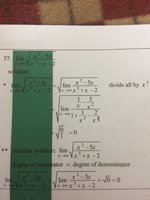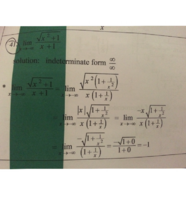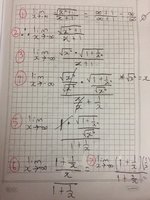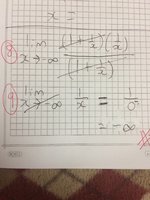You are using an out of date browser. It may not display this or other websites correctly.
You should upgrade or use an alternative browser.
You should upgrade or use an alternative browser.
How does it transform?
- Thread starter bbm25
- Start date
pka
Elite Member
- Joined
- Jan 29, 2005
- Messages
- 11,978
This is exactly the same misunderstanding you had before.Please help me?
I think i understand: √x² = |x| Because the square of x when square-rooted could be negative or positive. (Is my understanding correct?)
I do not understand: |x| = -x
If \(\displaystyle \large x<0\) then \(\displaystyle \large |x|=-x\).
Now as \(\displaystyle x\to -\infty\) it is the case that \(\displaystyle x<0\).
The Tan Gent
New member
- Joined
- Apr 15, 2019
- Messages
- 4
This is exactly the same misunderstanding you had before.
If \(\displaystyle \large x<0\) then \(\displaystyle \large |x|=-x\).
Now as \(\displaystyle x\to -\infty\) it is the case that \(\displaystyle x<0\).
On the other hand, if the limit was approaching positive infinity, it would be the case that X>0, so you would have put X instead of -X. It is a case-by-case situation.
Steven G
Elite Member
- Joined
- Dec 30, 2014
- Messages
- 14,603
Yes, if x>0 then |x| = x.
Yes, it is a case by case situation. Just look at the definition of |x|. Sometimes |x|=x and other times |x| = -x. So which definition do you use? Well it depends of the value of x. For example |-4| = -(-4) = 4 while |14| = 14
Yes, it is a case by case situation. Just look at the definition of |x|. Sometimes |x|=x and other times |x| = -x. So which definition do you use? Well it depends of the value of x. For example |-4| = -(-4) = 4 while |14| = 14
pka
Elite Member
- Joined
- Jan 29, 2005
- Messages
- 11,978
While that is true , it has nothing to do with what was asked.On the other hand, if the limit was approaching positive infinity, it would be the case that X>0, so you would have put X instead of -X. It is a case-by-case situation.
Yes, if x>0 then |x| = x.
Yes, it is a case by case situation. Just look at the definition of |x|. Sometimes |x|=x and other times |x| = -x. So which definition do you use? Well it depends of the value of x. For example |-4| = -(-4) = 4 while |14| = 14
Okay, so to be absolutely clear here, what this now means is, given the above, the following therefore either isn't correct, or more accurately, can be 'overridden' if the question says so?
"Just for exactness, it is not always true that the absolute value of a number is always positive. The absolute value of a number (like 0) can be 0. The correct statement is that the absolute value of a number is never negative."
(From the earlier thread here https://www.freemathhelp.com/forum/threads/absolute-value-formula.115520/#post-451402)
Dr.Peterson
Elite Member
- Joined
- Nov 12, 2017
- Messages
- 16,865
No, it's absolutely true (no pun intended). There is no overriding.
I think you are confusing the ideas of a number being negative (e.g. -3 is a negative number), and an expression containing a negative sign (e.g. -x is the negative of x). This is a very common mistake among beginners.
If x is negative, then -x, the negative of x, is positive. For example, if x = -3, then -x = -(-3) = 3, which is positive.
The absolute value of a number is either 0 (|0| = 0) or positive (|3| = 3 and |-3| = 3 are positive). This is true even when |x| is -x, because that happens only when x is negative.
I think you are confusing the ideas of a number being negative (e.g. -3 is a negative number), and an expression containing a negative sign (e.g. -x is the negative of x). This is a very common mistake among beginners.
If x is negative, then -x, the negative of x, is positive. For example, if x = -3, then -x = -(-3) = 3, which is positive.
The absolute value of a number is either 0 (|0| = 0) or positive (|3| = 3 and |-3| = 3 are positive). This is true even when |x| is -x, because that happens only when x is negative.
Steven G
Elite Member
- Joined
- Dec 30, 2014
- Messages
- 14,603
√x² = |x| since when you put in a positive number it comes out positive and if you plug in a negative you get back a positive number just like the absolute value function.View attachment 11776
Please help me?
I think i understand: √x² = |x| Because the square of x when square-rooted could be negative or positive. (Is my understanding correct?)
I do not understand: |x| = -x
Also, why do i have to convert √x² into |x| and only then divide each value by the highest power in the denominator as shown in the example above? Why can't i just take the denominator's highest power (which would be just √x²) and divide everything straight away without converting to absolute value first? What happens if i do not?
pka
Elite Member
- Joined
- Jan 29, 2005
- Messages
- 11,978
bbm25, this is my last try at helping you see this. You may need a live tutor to guide you step-by-step.Also, why do i have to convert √x² into |x| and only then divide each value by the highest power in the denominator as shown in the example above? Why can't i just take the denominator's highest power (which would be just √x²) and divide everything straight away without converting to absolute value first? What happens if i do not?
The whole point is to reduce \(\displaystyle \mathop {\lim }\limits_{x \to - \infty } \left( {\frac{{\sqrt {{x^2}} }}{x}} \right) = - 1\)
Thus we need to simplify \(\displaystyle {\frac{{\sqrt {{x^2}} }}{x}}\).
Well \(\displaystyle \sqrt {x^2}=|x|\), you said that you are O.K. with that.
How do we write \(\displaystyle |x|\) simply in terms of \(\displaystyle x\) 'alone' ? \(\displaystyle |x|=\begin{cases}x &: x\ge 0 \\ \Large -x &: x<0\end{cases}\)
You have asked repeatedly about that last point. Well once again: as \(\displaystyle x\to -\infty\) we have \(\displaystyle x<0\) so that \(\displaystyle |x|=-x\).
Once we have that then \(\displaystyle \mathop {\lim }\limits_{x \to - \infty } \left( {\frac{{|x|}}{x}} \right) = \mathop {\lim }\limits_{x \to - \infty } \left( {\frac{{ - x}}{x}} \right) = - 1\)
Dr.Peterson
Elite Member
- Joined
- Nov 12, 2017
- Messages
- 16,865
My standard answer to "what happens if I do something other than what you teach?" is, try it and see!Also, why do i have to convert √x² into |x| and only then divide each value by the highest power in the denominator as shown in the example above? Why can't i just take the denominator's highest power (which would be just √x²) and divide everything straight away without converting to absolute value first? What happens if i do not?
In this case, though, you might not see. The important thing here is that [MATH]\sqrt{x^2}[/MATH] is not merely a power of x, so you would very likely do something wrong without realizing it. If, when you try it, you don't get the right answer, show us what you did so we can point out the error.
You don't generally have to do things in just the order you are taught; sometimes it doesn't matter at all, and other times what we teach is the most efficient way, but other ways work too. The key idea here is that you must be aware that the square root must produce a non-negative value, which is what the absolute value does. If you didn't use the absolute value somewhere, you would have to be aware that since x is negative, you will at some point have a -x.
Also, why do i have to convert √x² into |x| and only then divide each value by the highest power in the denominator as shown in the example above? Why can't i just take the denominator's highest power (which would be just √x²) and divide everything straight away without converting to absolute value first? What happens if i do not?
This was in response towards the book! The picture i took, not towards what you've been teaching me! Apologies!!!
Steven G
Elite Member
- Joined
- Dec 30, 2014
- Messages
- 14,603
Fair question with a simple answer. While |x| sometimes equals x and other times equal -x it is the case that x ALWAYS equals x. So no need to replace x with -x (because they are NOT equal to one another)Why doesn't the x in the denominator (x + 1) also become -x?
Dr.Peterson
Elite Member
- Joined
- Nov 12, 2017
- Messages
- 16,865
This was in response towards the book! The picture i took, not towards what you've been teaching me! Apologies!!!
I don't think either of us took what you said as a criticism of what we have said; the issue is merely whether you understand the reasons for what you are taught, wherever. I was speaking as a general member of the teaching profession, referring to what you are taught by us or by your book or anywhere else.
So I was in fact referring to what the book teaches: It is not the only way. So if you aren't sure why they do it that way, try another way and learn from experience. Have you?
4) So my mistake is that i keep thinking that √x² = x and not |x|!!!! THANK YOU!!!
6) I will try to find the mistakes
9) i replace x with 0 instead of infinity because well.. that's what my book does
I also found it strange that my book replaces x with 0 instead of infinity but i found that if i do not do so, my answers wouldn't match the book's
6) I will try to find the mistakes
9) i replace x with 0 instead of infinity because well.. that's what my book does

I also found it strange that my book replaces x with 0 instead of infinity but i found that if i do not do so, my answers wouldn't match the book's
Also, i notice that in this particular solution, even though they asked for the limit as x approaches negative infinity, they actually didn't even divide everything by the highest power in the denominator! Doesn't that make the answer wrong?
Last edited:
Here
this guy (PatrickJMT on youtube if you know him) at 0:26, says that √x² = x.
1) So for absolute clarity, this guy is wrong, and √x² does not = x and actually = |x|. Correct?
2) He also divides everything by the highest power in the denominator, which the book does not do. Is he also wrong here?
1) So for absolute clarity, this guy is wrong, and √x² does not = x and actually = |x|. Correct?
2) He also divides everything by the highest power in the denominator, which the book does not do. Is he also wrong here?



